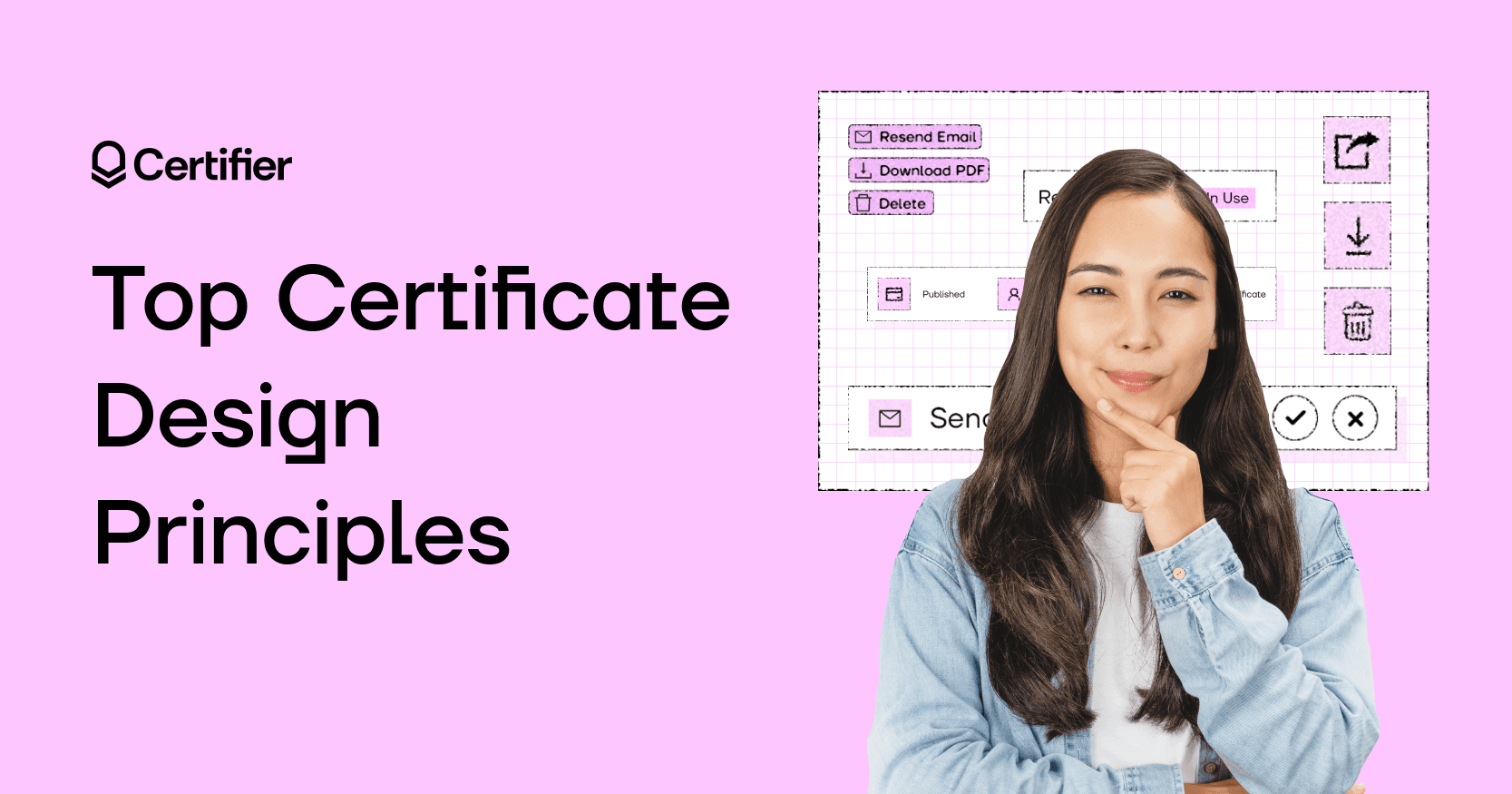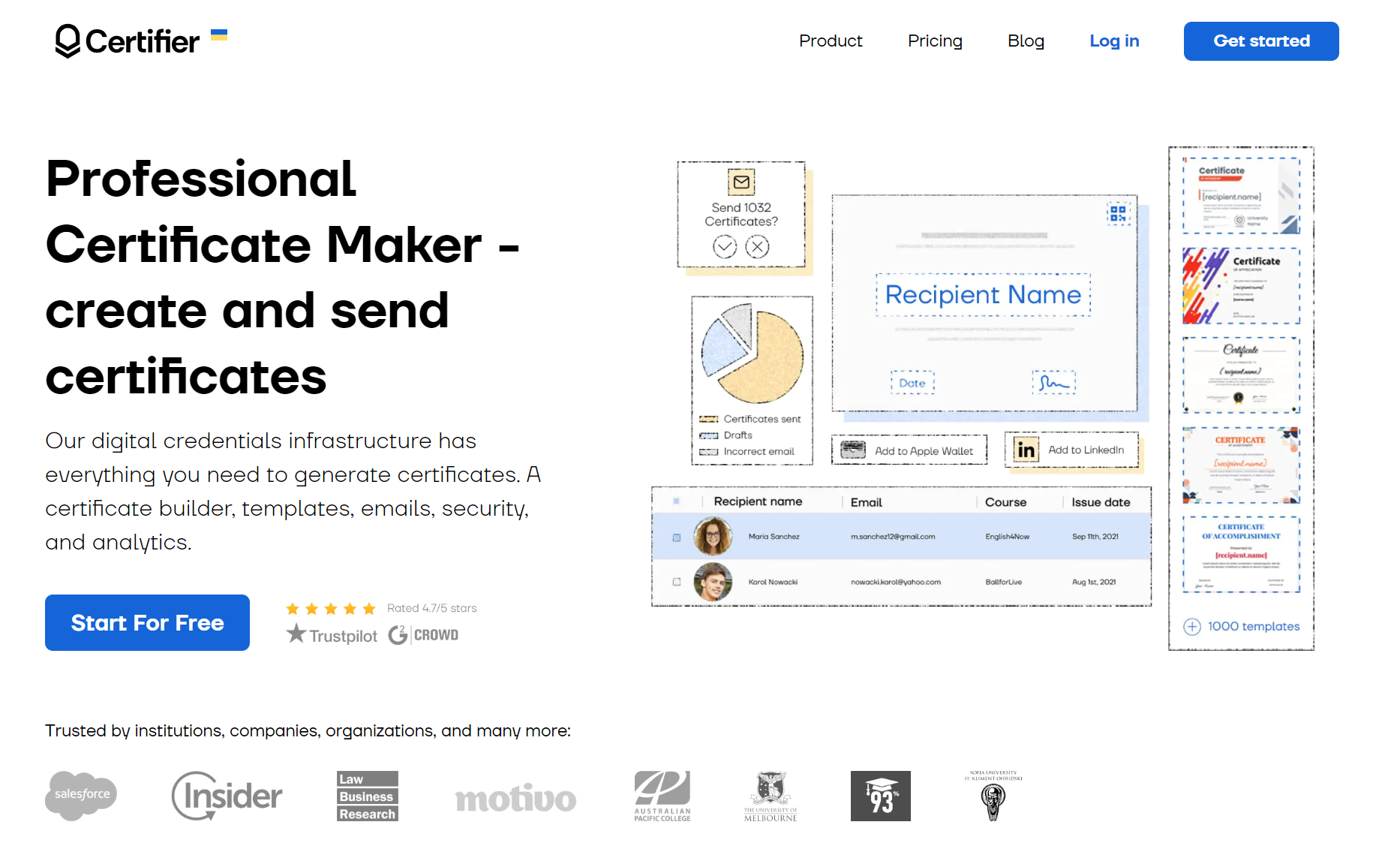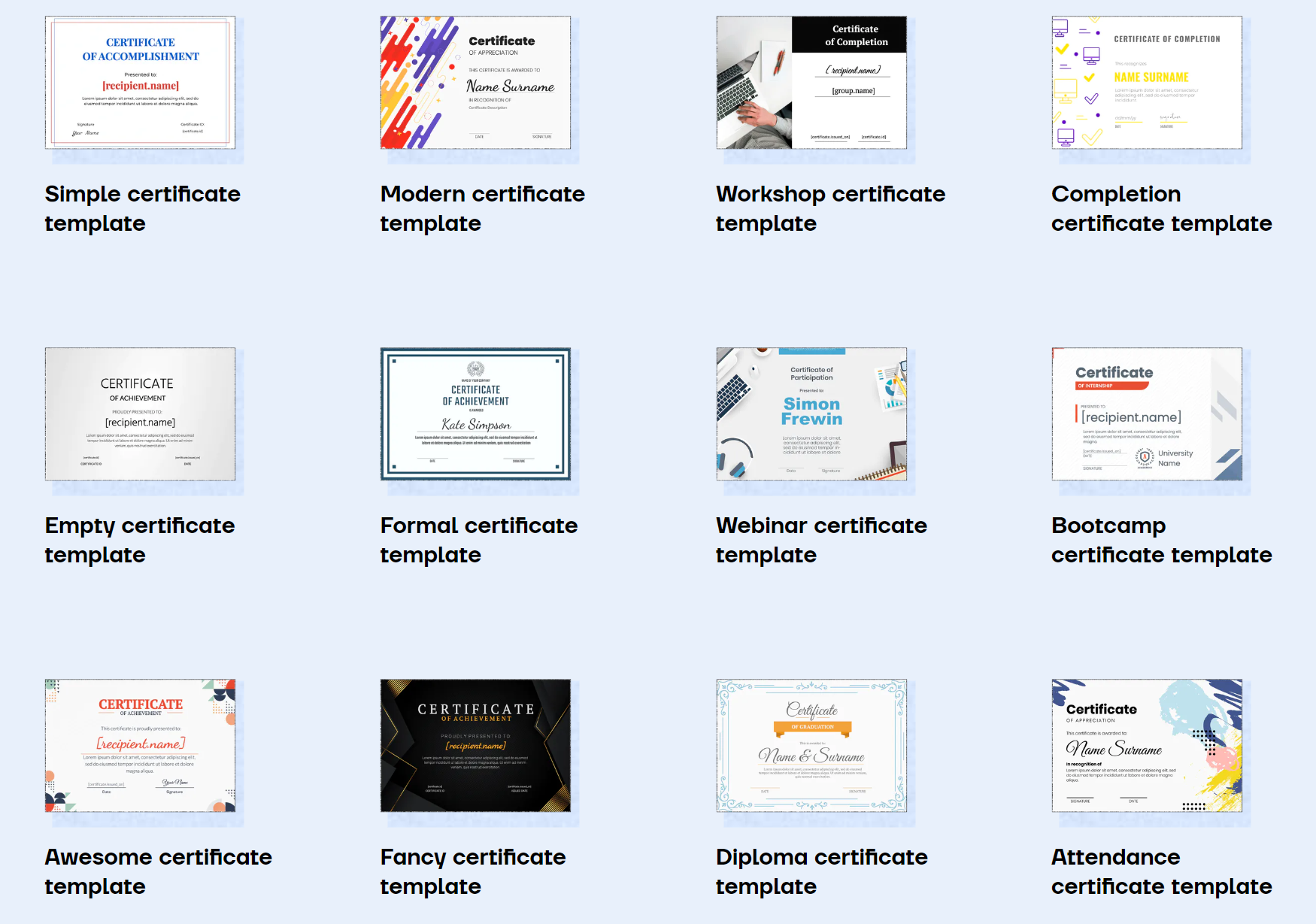Trusted by:
Top 8 Best Certificate Design Principles to Create a Lasting Impression
Do you want to create a certificate that makes a lasting impression on its recipients? Today we will discuss how to do this. Spoiler alert: you can make it for free and in a blink of an eye!
AuthorSergey Butko
Updated: January 30, 2024
6 min read

Author
Sergey Butko
Updated: January 30, 2024
6 min read
Trusted by:
In this article, we’ve covered eight tips that will allow you to create an impressive certificate design. Here's how to do it.
But before we get started, a few words about certificate design.
Why is certificate design so important?
There are a few reasons why it is essential.
👉 First, certificate design reflects your brand and may work as a business card. For example, if you have a well-designed certificate, it will show that you are a professional organization or company.
👉 Secondly, it can make a lasting impression on the recipient. A well-designed certificate will be remembered long after it is received.
👉 Finally, you can use it for marketing purposes. If you have a beautiful certificate, you use it to promote your brand or company. Also, with a solid tool for designing certificate templates, it is possible to monitor its social media performance, meaning how many people share them or add them to their LinkedIn profile.
What are some of the best certificate design principles?
There are a few crucial principles to keep in mind when designing a certificate. You might make a lasting impression with all of those so that recipients would remember your brand for a long time!
#1 Make your certificate professional and clean
First, make sure the design is professional and clean. A clean look might influence the first impression, so pay attention to the font sizes, photos, and colors. Combine all the elements in a coherent whole so that it would look streamlined and organized. The last thing you want is a cluttered or messy design. The good news is that you don’t have to be a designer to create such a document.
#2 Use high-quality images
Low-quality images would make your document look rather amateurish. So if you’re looking for free visual elements on the internet, try to select high-quality ones. When a certificate design is already decorative, look for images that would not clatter it. Visuals are great and might add a personal touch and originality.
#3 Ensure the layout is easy to read and fully legible
To make your certificate easy to read, consider how you would like it to look first. Then, even a quick plan would be helpful when designing the layout.
A good indicator is when you can quickly scan your document and find all the necessary information at first glance. And if you’re a little biased, ask someone to help you by taking a look at your certificate and suggesting changes.
#4 Use typography for an emphasis
In short, typography design is the art of arranging type to make written language readable. You make the message aesthetically pleasing and readable.
Typography involves:
choosing typefaces
point size
line length
line spacing
letter spacing
and more. Mind using typography while designing your certificate template.
Moreover, typography is great when you want to emphasize a piece of important information, such as the recipient's name, company name, or why they are being rewarded. Don’t be afraid to make some more extensive fonts, but keep it organized and readable.
#6 Design a printable certificate
While designing certificate templates, make sure they are easy to print. Even if you plan to create only digital certificates, making them printable is a good practice. Take care you deliver a suitable format for printing and high-quality for those who want to hang their document on the wall.
#7 Use color to add visual interest and contrast
Not only fonts but also colors are critical players in the game. For visual livening up, try to use some colors and draw attention to the crucial information. It is also a good idea to add some colors to, for example, an award certificate that matches your logo or refers to your course's topic. There are many color schemes and variations, so hopefully, you will find something you will be happy about.
For example, if you organize a water rescue course, you can make your certification in blue tones, so it refers to the water theme.
#8 Use a certificate template
You can use certificate templates found on the internet since there are so many of them. However, not each of them is editable and high-quality. Also, some of the available pre-made templates cannot be customized and, unfortunately, are not original. Therefore, making an impression with a commonly used template is barely possible.
You'll stand out with such nuances and well-thought details, and your modern certificate will make a lasting impression! However, it could be hard to design it with no tool, right? That’s why we want to introduce you Certifier – a cloud-based certificate templates generator.
If you are thinking about creating your certificate in MS Word, this article is for you ➡️ How To Make a Certificate in Word (And Why It’s a Bad Idea)
Master your certificate designs with Certifier
Certifier is an excellent tool for designing certificates for any occasion you need. So no matter whether you want to create an awards certificate, gift certificate, or maybe recognition, appreciation, or even an employee of the month certificate, Certifier will help you stay on top.

Here are over 30 ideas for certificates from Certifier. Read the article if you need some inspiration.
Thanks to many features, you can easily implement all the principles we’ve covered.
So let’s look at how Certifier works and what it offers!
01 Using free certificate templates (fully editable and easily customizable)
With a massive library of templates, you can choose a template you like and change the landscape orientation, colors, background – whatever you like.
Some good news here – Certifier provides free fonts. Also, all the elements are adjustable and editable – feel free if you want to tweak anything up. Add your logo, and visual elements, or sign it digitally. It’s all up to you.

02 Creating certificates from scratch
Thanks to certificate builders, making certificates, diplomas, or other credentials from scratch is a piece of cake. You can upload your own background and then all the elements. However, if you don’t have a background image, you can choose the certificate design that appeals to you the most and then remove all the text boxes with a single click. And now your background is ready for further changes!
03 Sending certification in bulk
Once you have your modern certificate designed, it’s time to print or send it to the recipients. With Certifier, it can take minutes!
Learn more about creating a certificate design quickly ➡️ How To Make Certificates in 15 Minutes
You can send certificates in bulk can be done in simple steps:
log in to Certifier (if you don’t have the account yet, click here to sign up)
prepare a CVS file with the recipients’ names and email addresses
design the documents or use a modern certificate template
upload the list and make a group
and send!
As simple as that. It is impossible to send credentials automatically when using programs like MS Word or Adobe Illustrator. But it is with Certifier!
04 Delivering verifiable documents
Besides providing many impressive certificates template and sending them in bulk, Certifier makes documents verifiable thanks to QR codes and verified issuer icons. So there’s no need to worry about falsifying certificates.
05 Sharing on social media
Shares on social media mean making a long-lasting impression on more people! After receiving a certificate award (or any other certificate type), your course attendees will be able to post them on social media, such as:
Facebook
Twitter
LinkedIn
and of course more! Those mentioned above can be tracked in your dashboard. In addition, you see social media insights like how many attendees added certificates on LinkedIn and how many shares there are on the rest of the social media channels.
06 Building printable certificates
With Certifier, you save money and time and create impressive certificates without learning how to design such documents. Moreover, compared to other tools such as Microsoft Word or Adobe Illustrator, Certifier provides you with simple yet powerful capabilities.
07 Managing certificates after sending
Have you sent the certificates, and it turned out there was a typo? You can edit sent credentials at ease. And you don’t need to design the template again. In your admin panel, you can:
renew certificates
resend them
edit credentials
delete if needed
many options here!
08 Storing your data in a secure place
Certifier is GDPR compliant. It is s a set of regulations for protecting digital data privacy. So you don’t need to worry about the security and confidentiality of all your private information.
Implement all the certificate design principles with Certifier!
Certifier is a perfect tool for educational institutions, companies of any size, or private use. It’s ideal for rewarding for hard work, completion of the course, participation in training, or expressing appreciation for some other achievements and events. With many customization options, your certificate or diploma will stay with the recipients for a long.
Sign up for free to create a lasting impression with certificate design!
Certificate Design Principles FAQs
How many design principles should you have?
The number of design principles you have will depend on the specific project you are working on. However, it is generally recommended that you have between 3 and 5 design principles. This will allow you to focus on the most important aspects of your design without becoming overwhelmed.
Why do design principles matter?
Having a clear set of design principles helps to ensure that your project is focused and cohesive. Design principles provide a framework for you to work within and can help to keep you on track as you progress through your project.
How do you create a good design principle?
When creating a design principle, you should aim to make it specific and actionable. A good design principle should be something that you can easily measure or test for.
What are some common certificate design mistakes?
Some common certificate design mistakes include:
Making the certificate too busy or cluttered
Using low-quality images or graphics
Not leaving enough white space
Trying to fit too much information onto the certificate
Using a difficult-to-read font
Not proofreading the certificate for errors
How can I make my certificates more unique?
Use Certifier to easily add images, logos, and text to your certificates to make them more personal and unique. You can also choose from a variety of fonts, colors, and paper types to further customize your certificates.

Sergey Butko
Tech entrepreneur. Forbes 30 Under 30 Europe. At Certifier, Sergey’s work focused on revolutionizing the way credentials, certificates, and badges are issued and managed through cutting-edge APIs and software infrastructure.
Sergey Butko
Tech entrepreneur. Forbes 30 Under 30 Europe. At Certifier, Sergey’s work focused on revolutionizing the way credentials, certificates, and badges are issued and managed through cutting-edge APIs and software infrastructure.
Share this article